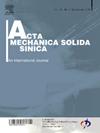A Trans-scale Shear-lag Model for Characterizing the Size Effect and Viscoelasticity of Staggered Shells
Abstract
Natural biomaterials with staggered structures exhibit remarkable mechanical properties owing to their unique microstructure. The microstructural arrangement can induce size-dependent and viscoelastic responses within the material. This study proposes a strain gradient viscoelastic shear-lag model to elucidate the intricate interplay between the strain gradient and viscoelastic effect in staggered shells. Our model clarifies the role of both effects, as experimentally observed, in governing the mechanical properties of these biomaterials. A detailed characterization of the size-dependent responses is conducted through the utilization of a microstructural characterization parameter alongside viscoelastic constitutive models. Then, the effective modulus of the staggered shell is defined and its formula is derived through the Laplace transform. Compared to classical models and even the strain gradient elastic model, the strain gradient viscoelastic model offers calculated moduli that are more consistent with experimental data. Moreover, the strengthening-softening effect of staggered structures is predicted using the strain gradient viscoelastic model and critical energy principle. This study contributes significantly to our understanding of the mechanical behavior of structural materials. Additionally, it provides insights for the design of advanced bionic materials with tailored properties.

 求助内容:
求助内容: 应助结果提醒方式:
应助结果提醒方式:


